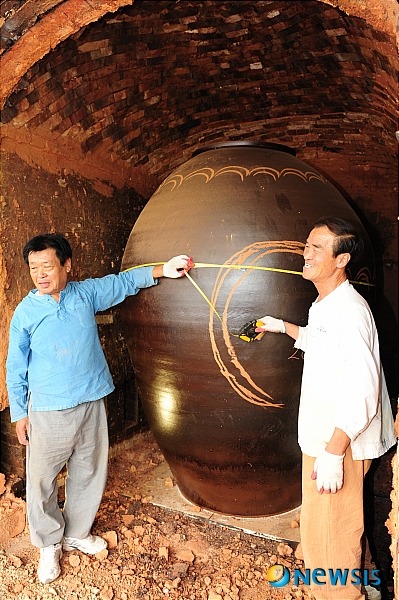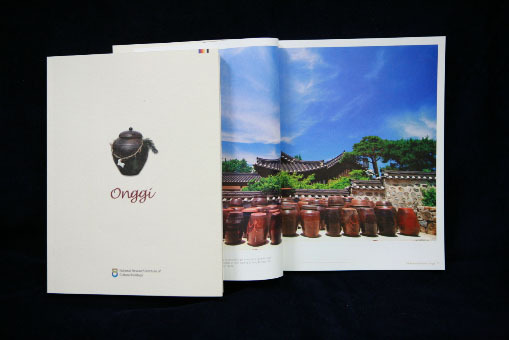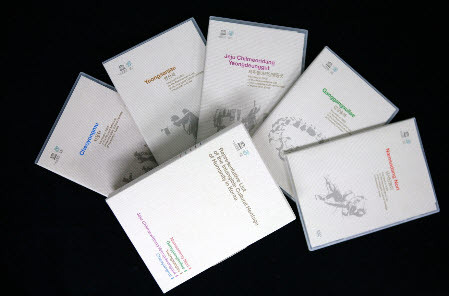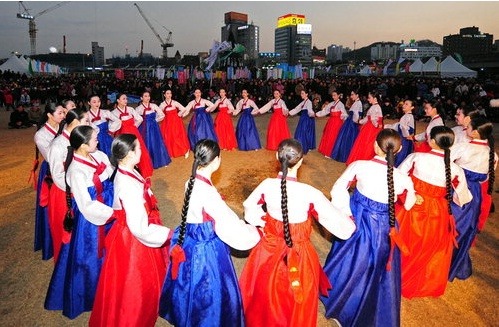Archive for January, 2011
[WSK] The house for Kimchi, Dwaenjang, and Gochujang
Ever wonder where they usually put the Kimchi, Dwaenjang, and Gochujang for the fermentation?
The pot is called Onggi.. it can be used to preserve various of food especially in winter. Furthermore, we’ll get to know about the Onggi it self.. I’m copying it from KoreaBrand website.. 🙂
Onggi, a traditional Korean pottery has a significant role as a container preserving food in Korean food culture. In fact, among this time is when we remind of the rows of kimchi and doenjang (soybean paste) jars that used to be stored in the house yard. Nowadays as plastic and stainless containers became popular and the housing environment has changed Onggi lost its popularity in daily life of Koreans. However, recently the cultural value and identity of Onggi has been acknowledged. Books written in English to promote a global use of Onggi have been published followed by attempts of contemporary interpretation on the traditional pot. Let’s take a closer look.
Onggi, traditional Korean pottery of daily life
Onggi, in Korean means earthenware or pottery with a dark brown glaze, which is a native Korean pottery of daily life. Often used as a kimchi jar, for its cheap price and long-durability has been generally used by Koreans. Onggi Folk Museum in Ssangmun dong, Seoul, possesses a variety of Onggi; the big ones mostly used for preserving soy sauce, doenjang, kimchi and water and others used in a more wide range of use e.g. chimneys, candle bottles, lamp-oil containers, Gi-wa(roof tile) and tea pots.
<The biggest Onggi made in Oe-gosan Onggi Village, height 229cm, girth 520cm>
The common use of Onggi can be explained with the characteristics of the Korean food culture. Onggi perfectly suits to preserve fermented food. Made from coarse sand-mud, its breathing holes allows air to enter but block water out that helps the preservation of the food for a longer duration. It also removes toxic substance of foods and reduces the smell. By enabling effective flow of air that helps the fermentation and preservation of the food, Onggi is perfect to store doenjang, soy sauce, kimchi and Jeotgal (salted seafood) keeping it fresh until the following year.
Especially, Onggi is a ‘pot from nature,’ that when cracked or broken to be thrown away it is simply back to earth as soil. The pot is made of soil, water, fire and wind that are harmless to our body. It is eco-friendly but also has traditional Korean scientific logics embedded, no surprise it was selected as one of ‘100 Cultural Symbols of Korea.’ Last year ‘Onggi Expo Ulsan Korea, 2010’ was hosted by Ulsan Oe-gosan Onggi village, the biggest Onggi trading center of Korea.
‘Onggi Expo Ulsan Korea, 2010’ under its theme ‘Onggi the Mirror of the Future’ introduced Onggi featuring the meanings found in its materials and decoration technology and also offering events to experience the difference between Onggi and other potteries from the world. It was the first international expo on traditional Onggi and especially its event for visitors to make their own Onggi was a great success.
CHA publishes an English edition book on Onggi
The National Research Institute of Cultural Heritage (NRICH), Cultural Heritage Administration of Korea published a book entitled as ‘Onggi’ written in English to introduce the Onggi culture to the world. In order to help the orientation of foreigners lots of visual images are included for explaining the production process of Onggi. The process is introduced by three themes – earth, fire and spirit, which are the essential elements for making the pot throughout the history. Among the three, spirit is the most critical that contains the heart of the artisan who made the pot.
This book will be distributed overseas through Korean Culture and Information Services and other related organizations. Also the PDF version will be available at the (NRICH) homepage (www.nrich.go.kr). In addition, NRICH based on their research on intangible cultural heritage of Korea, will continue to publish other English books for foreigners.
Due to the change of housing environments and industrial progress, there are less people who use Onggi in daily life, especially with the invention of kimchi refrigerator in Korea. A significant effort to establish the identity of Onggi culture inheriting its excellence as a traditional container for fermented food, and its historic and cultural value as deriving from the early pottery of human history, should be continued. To develop Onggi suitable for practical use in contemporary life or application to interior design can be one idea. Through a long-term and specific plan, a spread of traditional Onggi culture of Korea across the world is hopefully to be expected.
LVR – Salju deras di cheonan
salju deras lg.. dingin.. mang bener kata si tika, winter lebih indah dilihat, ketimbang dirasakan.terutama bila sang kekasih tak ada di sisi.. hahai
=============== LG U+ 모바일 =====================
휴대폰에서 발신된 메일입니다.
본 메일은 발신 전용 메일로, 회신이 불가능합니다.
Aku Cinta Dia – Gita Gutawa
bismillah..
Lirik Lagu Gita Gutawa – Aku Cinta Dia
src: here
Di saat kau berjalan
Di muka rumahku, penuh gaya
Tersita pandanganku hingga ku terpesona
Siapakah dirimu hatiku ingin tahu, segera
Reff:
Hati yang berbunga
Pada pandangan pertama
Oh Tuhan tolonglah
Aku cinta, ku cinta dia
Di manakah rumahmu
Siapakah namamu, sebutkanlah
Kuingin berkenalan, terimalah salamku
Gayamu dan wajahmu, terbawa dalam mimpi
Diriku, dimabuk asmara
Reff 2x
[WSK] Sharing the beautiful culture of Korea
Cultural Heritage can be divided into tangible and intangible heritage. Cultural assets with forms e.g. a palace or ceramics would belong to the former category, while formless assets such as music, dance, drama, and recreations would belong to the latter one. Especially the legacy of intangible cultural assets has been continued by the people throughout history until now, being re-created by time contributing to the diversity of culture.
UNESCO has well acknowledged the importance of intangible cultural heritage. In 1997, at the 29th UNESCO general assembly it has adopted ‘Masterpieces of the Oral and Intangible Heritage of Humanity’ in order to protect intangible heritage which has been under threat to cease to exist by industrialization and globalization.
In 2003 ‘Convention for the Safeguarding of the Intangible Cultural Heritage’ was adopted by UNECO and it designated an ‘Urgent Safeguarding List’ and ‘Representative List’ of intangible cultural heritage of humanity. In 2001, 19 assets have been assigned as intangible cultural heritage and the list of it is on increase since then. Last October the food culture of France and Mexico was added to the list receiving lots of attention.
CHA produces DVD on Intangible Cultural Heritage of Humanity
Half of cultural assets inscribed on the UNESCO Intangible Cultural Heritage List are those of Korea, China and Japan; Kabuki theater of Japan, the Dragon boat festival and Acupuncture and moxibustion of traditional Chinese medicine of China. Korea has eleven assets on the list; the Royal Ancestral Ritual in the Jongmyo Shrine and its Music, the Pansori Epic Chant, the Gangneung Danoje Festival, Cheoyongmu, Ganggangsullae, Jeju Chilmeoridang Yeongdeunggut, Namsadang Nori, Yeongsanjae, as well as Daemokjang (traditional wooden architecture), Gagok (lyric song cycles accompanied by an orchestra), and Falconry the last three recently added to the list.
The National Research Institute of Cultural Heritage (NRICH), Cultural Heritage Administration of Korea produced contents with foreign language services introducing the eleven assets distributed by this month. A video clip on five assets inscribed on 2009 (Cheoyongmu, Ganggangsullae, Jeju Chilmeoridang Yeongdeunggut, Namsadang Nori, Yeongsanjae) is as well produced in three language editions with Korean, English and French. The clip includes a brief introduction on each relevant item that will be a useful resource for foreigners interested in Korean culture.
To promote active use of it, NRICH will distribute those video clips to relevant organizations and researchers in Korea and overseas, as well as providing online access to the material at NRICH homepage. High-quality contents on the intangible cultural heritage of Korea acknowledged by UNESCO is planned to be developed, produced and distributed every year. Such attempts is expected to improve a worldwide recognition on those heritages of Korea that has been under-promoted, despite of its value and significance representing the history, culture and identity of Korea.
The Intangible Cultural Heritage, the dwelling place for the Korean Spirit
<Namsadang Nori, No.3 Important Intangible Cultural Properties of South Korea>
Let’s take a closer look to the five cultural assets featured on the DVD produced by NRICH.
Namsadang Nori is the no.3 important intangible cultural properties of South Korea. Literally meaning ‘all-male vagabond clown theatre,’ it is a traveling entertaining theater troupe consisted of forty to fifty men enjoyed by the common people.
Kkokdusoe (the head of the group) leads the group followed by gombaengisoe, tteunsoe, gayeol, ppiri, and jeoseungpae performing the six sessions of nori (recreation) that are Pungmul, Beona, Salpan, Eoreum, Deotboegi, and Deolmi. Its origin derives from late Joseon. It was to wish peace and wealth for the villages and deliver joy to the common people through various music and performance.
Ganggangsullae, the no.8 important intangible cultural properties of South Korea, is a more familiar traditional recreation of Korea. The tradition comes from the South-western area of Korea performed to wish good harvest and fecundity.
Especially a grand Ganggangsullae used to be performed on the night of Chuseok (Korean Thanksgiving), which origins back from the Japanese Invasion of Korea in 1592. Admiral Yi Sun-shin lighted up torches on the hill and gathered women to play Ganggangsullae to fake the size of the army to the enemy and later the play continued to sing joys and sorrows of life.
<Ganggangsullae, No.8 Important Intangible Cultural Properties of South Korea>
Cheoyongmu is the final dance of Narye and Yeonre, successive national royal events of Korea. It is the only royal dance performed with human face masks. The narrative of the dance is about getting rid of misfortune based on the principle of Yin-Yang and the Five Elements. Through its dazzling and confident movements the dance delivers great energy and vigor to the audiences.
Yeongsanjae is a kind of 49 jae (a Buddhist memorial ceremony held on the 49th day of one’s death). It is a ceremony for spirits to attain eternality based on the Buddhist faiths. It cultural value is recognized for reproducing Young-san Hwe-sang, reminiscences of preach Sakyamuni has performed on Vulture Peak Mountain; also called as Young-san jak Bup, a representative providence ceremony of Buddhism.
Jeju Chilmeoridang Yeongdeunggut is a kind of haenyeo gut (haenyeo means female diver, gut is a type of exorcism) that is part of the unique cultural heritage of Jeju along with haenyeo and folk religion. It has a cultural meaning as a cultural festival embracing the local community and encouraging mutual understanding between the people living on Jeju Island.
To preserve these inherited cultural assets of Korea an active promotion on the international stage should be continued. An active support and participation from the Korean people preserving and promoting their cultural heritage should be followed as well.
Word Tagger
bismillah..
versi pertama cuma bisa bantu orang nerjemahin kata dan nyelesai Teka-teki silang.. 🙂
next version.. kita bakal bisa bikin word cloud or some sort of..
Isi dengan wildcard (% atau *) seperti regular expression yang artinya any number of any letter. Dan gunakan tanda tanya (?) atau underscore (_) untuk merepresentasikan satu karakter huruf.
Contoh : lo* akan menampilkan kata2 “love”, “lock”, “lontong”, etc..
enjoy.. 🙂
Quote of The Day
bismillah..
”When you want something, all the universe conspires in helping you to achieve it.”
~Paulo Coelho
Saleum – KCB OST
(download)
Salamu’alaikom warahmatullah
Jaroe dua blah ateuh jeumala
Kedua belah tangan di tas jemala
Jaroe lon siploh di ateuh ule
sepuluh tanganku ini di atas kepala
Meuah lon lake bak kawom dumna
Mohon maaf kuhaturkan kepada semuanya
Jaroe lon siploh di ateuh ubon
Sepuluh tanganku ini diatas ubun
Salamu’alaikom lon tegur sapa
Salam alaikum, ku tegur sapa..
Jaroe lon siploh beu ot sikureng
Jari tanganku yang sepuluh kuangkat sembilan
Syarat ulon khen tanda mulia
Sebagai syarat, tanda mulia
Jaroe sikureng lon beu ot lapan
Jari sembilan kuangkat delapan
Geunan to timphan ngon aso kaya
Ganti timphan dengan isi srikaya
Jaroe lon lapan lon beuot tujoh
Jari tanganku yang delapan kuangkat tujuh
Ranup lam bungkoh lon jok keu gata
Sirih dalam bungkus ku serahkan pada tuan
Adh-Dhuha – Hamil
(download)
|
| 1. | وَالضُّحَىٰ | |
| Demi waktu matahari sepenggalahan naik, | ||
| 2. | وَاللَّيْلِ إِذَا سَجَىٰ | |
| dan demi malam apabila telah sunyi, | ||
| 3. | مَا وَدَّعَكَ رَبُّكَ وَمَا قَلَىٰ | |
| Tuhanmu tiada meninggalkan kamu dan tiada (pula) benci kepadamu , | ||
| 4. | وَلَلْآخِرَةُ خَيْرٌ لَكَ مِنَ الْأُولَىٰ | |
| dan sesungguhnya akhir itu lebih baik bagimu dari permulaan . | ||
| 5. | وَلَسَوْفَ يُعْطِيكَ رَبُّكَ فَتَرْضَىٰ | |
| Dan kelak Tuhanmu pasti memberikan karunia-Nya kepadamu, lalu (hati) kamu menjadi puas. | ||
| 6. | أَلَمْ يَجِدْكَ يَتِيمًا فَآوَىٰ | |
| Bukankah Dia mendapatimu sebagai seorang yatim, lalu Dia melindungimu. | ||
| 7. | وَوَجَدَكَ ضَالًّا فَهَدَىٰ | |
| Dan Dia mendapatimu sebagai seorang yang bingung , lalu Dia memberikan petunjuk. | ||
| 8. | وَوَجَدَكَ عَائِلًا فَأَغْنَىٰ | |
| Dan Dia mendapatimu sebagai seorang yang kekurangan, lalu Dia memberikan kecukupan. | ||
| 9. | فَأَمَّا الْيَتِيمَ فَلَا تَقْهَرْ | |
| Adapun terhadap anak yatim maka janganlah kamu berlaku sewenang-wenang. | ||
| 10. | وَأَمَّا السَّائِلَ فَلَا تَنْهَرْ | |
| Dan terhadap orang yang minta-minta maka janganlah kamu menghardiknya. | ||
| 11. | وَأَمَّا بِنِعْمَةِ رَبِّكَ فَحَدِّثْ | |
| Dan terhadap ni’mat Tuhanmu maka hendaklah kamu menyebut-nyebutnya (dengan bersyukur). |
Sit-up for life..
bismillah..
if you fell and lay.. don’t forget to get up again.. 😀
.
sit-up in the snow..fun
NB: perut gua sakit keesokan harinya.. huehue
*** update ***
2011/01/10 18:12 pm -> perut gua masih sakit.. -___-“
Quote of The Day
bismillah..
Dan tiadalah kehidupan dunia ini, selain dari main-main dan senda gurau belaka. Dan sungguh akhirat itu lebih baik bagi orang-orang yang bertaqwa. Maka tidakkah kamu memahaminya?
Eng.Trans:
What is the life of this world but play and amusement? But best is the home in the hereafter, for those who are righteous.
QS Al An’am : 32















Komen Terbaru